Introduction
When applying for a scholarship, a recommendation letter can significantly impact your chances of success. A well-crafted recommendation letter showcases your strengths, achievements, and potential, providing valuable insights to the scholarship committee. In this article, we will explore the essential elements to include in a recommendation letter for a scholarship. From highlighting your academic accomplishments to showcasing your character traits, we will guide you through the process of creating a compelling and effective recommendation letter that increases your chances of securing the scholarship you desire.
What to Include in a Recommendation Letter for a Scholarship
A recommendation letter for a scholarship should provide a comprehensive overview of your qualifications, accomplishments, and potential as a candidate. Here are some key elements to include in your letter:
1. Introduction and Context
In the first paragraph, introduce yourself and your relationship to the applicant. Explain how you are acquainted with the applicant and in what capacity you have worked together. This helps establish your credibility and provides context for the rest of the letter.
2. Academic Achievements
Highlight the applicant’s academic achievements, including their grades, class rank, and any notable awards or honors they have received. Discuss their intellectual abilities, work ethic, and dedication to their studies. Providing specific examples and anecdotes can make the letter more compelling and memorable.
3. Extracurricular Activities and Leadership Skills
Describe the applicant’s involvement in extracurricular activities such as clubs, sports, or community service. Emphasize their leadership skills, teamwork abilities, and commitment to making a positive impact. This demonstrates their well-roundedness and ability to balance academic and non-academic responsibilities.
4. Personal Qualities and Character Traits
Discuss the applicant’s personal qualities and character traits that make them an exceptional candidate for the scholarship. Are they compassionate, resilient, or innovative? Share stories or instances where the applicant demonstrated these qualities, showcasing their unique strengths and attributes.
5. Career Goals and Aspirations
Explain the applicant’s career goals and aspirations, demonstrating their passion and dedication to their chosen field of study. Discuss any relevant experiences, internships, or research projects they have undertaken that align with their future plans. This shows the scholarship committee that the applicant has a clear vision for their future and is committed to making a difference in their chosen field.
6. Impact and Contributions
Highlight the applicant’s potential to make a significant impact in their field of study or community. Discuss their past contributions and how they have positively influenced others. This could include mentoring fellow students, volunteering, or initiating meaningful projects. By showcasing the applicant’s ability to effect change, you strengthen their candidacy for the scholarship.
7. Conclusion
In the final paragraph, summarize the key points of the recommendation letter, reiterating the applicant’s qualifications, accomplishments, and potential. Express your confidence in the applicant’s ability to succeed and make a positive impact if awarded the scholarship. End the letter with a strong closing statement and your contact information, should the committee have any further questions.
Frequently Asked Questions (FAQs)
1. What is the ideal length for a recommendation letter for a scholarship?
A recommendation letter for a scholarship should typically be one to two pages long. It should be concise and focused while providing sufficient details to support the applicant’s candidacy.
2. Should I include both academic and non-academic achievements in the letter?
Yes, it is important to include both academic and non-academic achievements in the letter. This provides a well-rounded view of the applicant’s abilities, strengths, and potential.
3. Can I use bullet points or lists in the recommendation letter?
While it is generally recommended to use paragraphs for a recommendation letter, you can incorporate bullet points or lists sparingly to highlight key accomplishments or qualities. However, ensure that the overall structure of the letter remains coherent and organized.
4. Is it necessary to address any weaknesses or areas for improvement in the letter?
While it is not essential to address weaknesses or areas for improvement, if the applicant has overcome significant challenges or demonstrated remarkable growth, it can be beneficial to mention these instances. However, always maintain a positive and supportive tone in the letter.
5. How should I format the recommendation letter?
Format the recommendation letter using a professional and business-like tone. Use a standard font and size, maintain proper spacing, and include your contact information at the end of the letter. Consider using letterhead if available.
6. Can I submit additional supporting documents along with the recommendation letter?
In most cases, scholarship applications have specific guidelines regarding the submission of supporting documents. If allowed, you can include additional materials such as transcripts, certificates, or a resume to complement the recommendation letter. However, be sure to follow the application instructions carefully.
Conclusion
Crafting a compelling recommendation letter for a scholarship is a crucial step in the application process. By including the right elements such as academic achievements, extracurricular activities, personal qualities, and career goals, you can effectively showcase the applicant’s qualifications and potential. Remember to provide specific examples and anecdotes to make the letter engaging and memorable. With a well-crafted recommendation letter, you increase the likelihood of securing the scholarship and furthering your educational goals.



